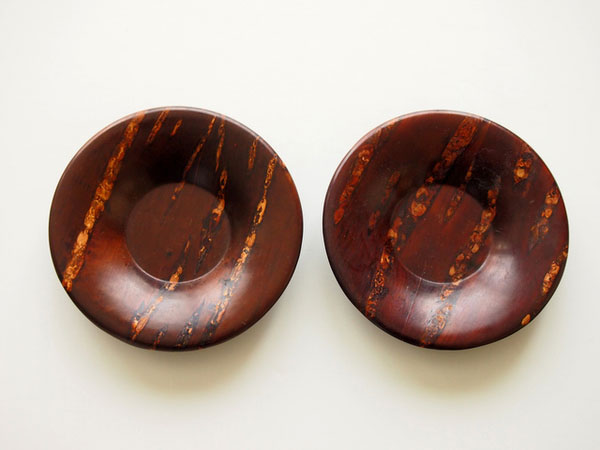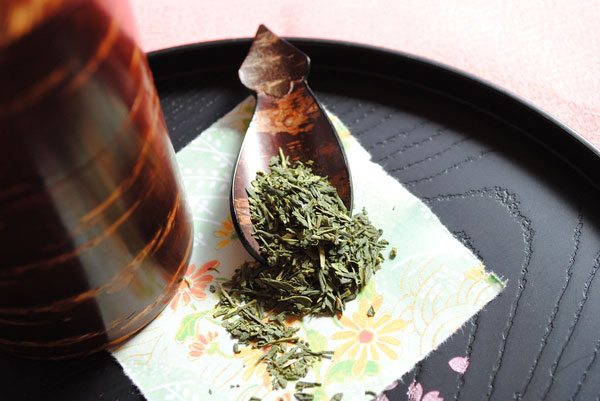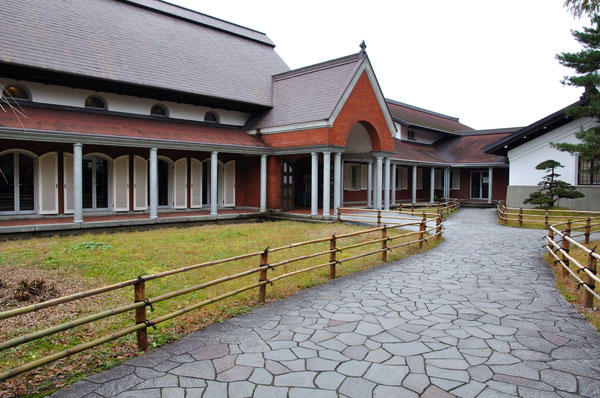
- Wood, bamboo crafts
- Akita
Kaba cherrybark woodcrafts Kaba zaiku
Traditional crafts from the Edo period
The beauty of cherry tree bark
Description
What is Kaba cherrybark woodcrafts ?
Kaba cherrybark woodcrafts (called Kaba zaiku in Japanese) are a type of wood bark craft produced in the former town of Kakunodate, Akita prefecture. While the character for kaba means birch, for this context the word refers to the bark of wild cherry trees. Within Japan, only Akita prefecture has passed down the knowledge of using Kaba cherrybark in woodwork so the craft is valued as a model craftwork of Japan.
The notable features of Kaba cherrybark are its durability, and ability to both retain and repel moisture. The sheen, subdued colors, and the natural beauty of the cherrybark patterns lend themselves to the production of an extensive range of attractive items. Being small and light, Kaba cherrybark woodcrafts are known for being ideal souvenirs like tea utensils such as caddies, scoops, and saucers. They also make good gifts such as organization boxes, flower vases, cell phone straps, and accessories like barrettes, brooches or pendants.
Kaba cherrybark woodcrafts are made by applying one of the following three techniques: katamono, kijimono, and tatamimono. Katamono is typically used for tea caddies and a paper-thin wood sheet and bark are wound around a cylindrical wooden block and glued together by pressing with a heated trowel. Kijimono is used for box-shaped items such as letter boxes or trays and the bark is glued onto a wood base. In tatamimono, a more recent innovation, layers of polished bark are glued to create thickness and subsequently carved.
History

The beginning of Kaba cherrybark woodcrafts can be traced back between 1781 and 1788, when a samurai named Hikoroku FUJIMURA brought the techniques from the Ani area up north down to the former town of Kakunodate, Akita prefecture. At first, the crafts provided a supplementary income for lower ranking samurai; however, the governing Satakekita family encouraged production and developed the local industry. During that time, the main products were small accessories like netsuke (miniature carvings attached to the end of a cord hanging from a pouch) and pouches used to carry personal name stamps, medicine or tobacco. Some historians say these items were popular as gifts when feudal lords took up their alternate-year of residence in Edo (former name of Tokyo).
During the Meiji period (1868-1912), many samurai were out of a job and took up producing Kaba cherrybark woodcrafts as a source of income. Later, with this influx of artisans, an improvement of tools, and the emergence of powerful wholesalers, the craftwork developed into a stable industry. Then, folk-arts movement leader Muneyoshi YANAGI (1889-1961) and the master artisans of the era further improved the techniques and increased the value of the craft. Around 1965, the tatamimono technique was developed. In 1976, Kaba cherrybark woodcraft was Akita prefecture's first craft to be designated a traditional craft. Since then, the outstanding skills have been passed down with great care and products in harmony with modern lifestyles have been continuously added.
General Production Process
- 1. Stripping bark
In August and September, wild cherry trees judged to contain plenty of water and possess excellent health are selected for bark stripping by specialist craftsmen. The bark of older trees, survivors of harsh winter winds and snow is particularly prized for its beautiful appearance. A special blade is used to cut a line measuring about 30 centimeters (about 11.8 inches) into the bark which is peeled in such a way as to allow the tree to continue growing. Trees are marked to allow alternate sections of regrowth known as "second-time bark" which is highly valued. The stripped bark is often stored in the rafters of the workshop and left to dry for about two years before being worked on.
- 2. Shaving bark
Bark is classified into twelve types according to condition and color. For example, bark of the highest grade will resemble crepe fabric, have a good sheen with vertical cracks, or have a good amber color.
To make a tea caddy, first a length of bark is selected and cut to size, dampened with water, and a heated trowel is used to steam any curling. Then the bark surface is shaved with the edge of a carving blade knife which not only thins the bark but brings out its luster.
- 3. Applying glue
After applying glue to the thinly shaved bark, it is left to dry.
- 4. Curling
The bark is wound around a wooden model and a heated trowel is pressed against it to give a tubular shape. Once curled, the bark is removed from the wooden model and polished.
- 5. Gluing
Glue is applied to the base wood material and the bark is attached. Synthetic glues often cause creases, so an animal glue is applied with a heated trowel. This step requires proficient technique because it is incredibly difficult to ensure the right temperature and prevent burning or creasing. In Kaba cherrybark workshops there is always a fire to warm the animal glue and heat the trowel.
- 6. Fitting the top and bottom
The top and bottom parts of the cylindrical tea caddy are made. A small knife and a hand plane are used to smooth the rim. Similarly to the body section, animal glue is applied with a heated trowel to glue the bark. After the top part is finished, the same thing is done for the bottom part.
- 7. Polishing
To give more sheen to the bark surface, a polishing tool made of such natural polishing materials like scouring rushes or muku tree leaves is used to polish multiple times. After shining with polishing powder, a small quantity of oil is applied and polished with a cloth to finish. During this step, the natural subdued deep color and sheen of cherry tree bark is brought out without needing paint. The natural beauty of cherry tree bark lives on in the practical Kaba cherrybark woodcrafts.
Where to Buy & More Information
Kakunodate Kaba Craft Densho-kan

-
Address
-
Tel.+81-187-54-1700
-
ClosedAround the New Year
-
Business HoursApril to November 9am to 5pm December to March 9am to 4:30pm
-
Website
See more Wood, bamboo crafts
- Hakone wood mosaic
- Iwayado traditional chest
- Kaba cherrybark woodcrafts
- Odate bentwood
- Inami wood carvings
- Matsumoto furniture
- Beppu bamboo crafts
- Edo wood joinery
- Ichii woodcarvings
- Suruga bamboo crafts
- Edo bamboo fishing rods
- Kishu bamboo fishing rods
- Kamo traditional chest
- Kyo wood joinery
- Miyakonojo archery bows
- Osaka carved wooden panel
- Miyajima woodwork
- Nibutani carved wooden tray
- Okuaizu Basketry
- Echizen traditional chest
- Kasukabe traditional paulownia chest
- Katsuyama bamboo crafts
- Osaka karaki wood joinery
- Takayama tea whisks
- Toyooka wicker crafts
- Akita cedar tubs and barrels
- Nagiso woodturning
- Kishu traditional chest
- Nagoya traditional paulownia chest
- Osaka bamboo screens
- Osaka-senshu traditional paulownia chest
- Sendai traditional chest































































































































































































































































































